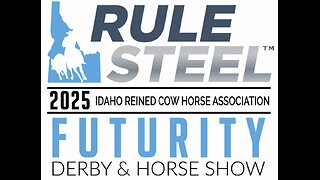Premium Only Content

Coal Blasting Gone Wrong
Coal Blasting Gone Wrong
Blasting
Blasting is an integral part of surface mining operations. To uncover coal reserves, the rocks overlying the coal are broken with explosives and excavated with various types of large earth-moving equipment. Without blasting, a vital part of the nation's energy reserve would be inaccessible
The Surface Mining Control and Reclamation Act of 1977 (SMCRA) requires that coal mining be conducted in a manner that prevents injury to people and damage to public or private property during blasting. The side effects of blasting include:
Flyrock - a rock or rocks moving through the air or along the ground after a blast and travel beyond the blast area (security zone).
Ground vibrations - a seismic wave that moves through the ground following a blast.
Airblast - a concussion (or pressure) wave that moves through air following a blast.
Fumes - the gaseous byproducts that are the result of an explosives detonation.
Dust - small particles of earthen material that may be temporarily suspended in air.
The most dangerous and apparent of these is flyrock. Injury or death to people and property damage may happen when a piece of rock is thrown beyond the permit boundary. The blaster is responsible for preventing flyrock and controlling ground vibration, airblast and fumes. OSMRE oversees the only national program to certify blasters. Training provided for blaster certification addresses the control of flyrock, vibrations, airblast and fumes by the appropriate use of explosives and hazard recognition in the field.
Ground vibrations and airblast may cause people's homes to shake. When people feel their homes shake, they may associate damage to their homes as being a direct result of blasting at a surface coal mine.
https://www.osmre.gov/programs/regulating-active-coal-mines/blasting
Coal is a combustible black or brownish-black sedimentary rock with a high amount of carbon and hydrocarbons. Coal is classified as a nonrenewable energy source because it takes millions of years to form. Coal contains the energy stored by plants that lived hundreds of millions of years ago in swampy forests
-
 1:17
1:17
Rumblestuff
14 days agoCopy Cats - Cats copying their owners
243 -
 1:06:36
1:06:36
Wendy Bell Radio
9 hours agoPet Talk With The Pet Doc
51.9K28 -
 30:58
30:58
SouthernbelleReacts
2 days ago $6.77 earnedWe Didn’t Expect That Ending… ‘Welcome to Derry’ S1 E1 Reaction
31.8K8 -
 13:51
13:51
True Crime | Unsolved Cases | Mysterious Stories
5 days ago $16.11 earned7 Real Life Heroes Caught on Camera (Remastered Audio)
48.9K10 -
 LIVE
LIVE
Total Horse Channel
15 hours ago2025 IRCHA Derby & Horse Show - November 1st
127 watching -
 4:19
4:19
PistonPop-TV
6 days ago $7.18 earnedThe 4E-FTE: Toyota’s Smallest Turbo Monster
41.5K -
 43:07
43:07
WanderingWithWine
6 days ago $4.01 earned5 Dreamy Italian Houses You Can Own Now! Homes for Sale in Italy
30.6K9 -
 LIVE
LIVE
Spartan
1 day agoFirst playthrough of First Berserker Khazan
125 watching -
 28:01
28:01
Living Your Wellness Life
2 days agoTrain Your Hormones
24.6K1 -
 43:28
43:28
The Heidi St. John Podcast
1 day agoFan Mail Friday: Faith Over Fear and Finding Strength in Every Season
14.9K